Turkish cuisine scrumptious traditional Turkish foods to try
Turkish food is one of the best in the world. Turkey is a country in a unique position geographically lying partly in Europe and partly in Asia. Sitting at these historic crossroads Turkish food combines both these cultures to create some of the finest dishes in the world.
Traditional Turkish food is among the richest cuisines in the world. The variety of Turkish cuisine comes from a rich culinary history and culture due to its prime location on the cusp of both the western and eastern worlds. Turkish food is considered one of the world’s three main cuisines and it sits aside Chinese and French traditions.

Turkey is, for the most part, a Muslim country and you won’t find many pork or pork products here. Sorry, no bacon in Turkey.

- Turkish cuisine scrumptious traditional Turkish foods to try
- Traditional Turkish Foods to Try
- 1. What are some traditional Turkish foods that one must try?
- 2. What is a typical Turkish breakfast like?
- 3. Can you recommend some popular Turkish street foods?
- 4. What are some traditional Turkish desserts that are a must-try?
- 5. How is Turkish coffee different from regular coffee?
- 6. Are there any vegetarian options in traditional Turkish cuisine?
- Is Turkish Food Spicy (hot)?
- Traditional Turkish Tea
- What are traditional Turkish foods?
- 38 Turkish foods to try when visiting
- Turkish Street Food
- Turkish Food favourites
- Turkish Soups
- Turkish vegetarian food
- Traditional Turkish Desserts
- Traditional Turkish Foods to Try
Xyuandbeyond is reader-supported. When you buy through links on our site, we may earn an affiliate commission. You can read my privacy policy here.
Traditional Turkish cuisine has been very dependent on meat products for centuries. The main meats consumed in Turkey prior to modern days was horse and sheep. Turks also planted and harvested fruits and vegetables including wheat, barley, maize, corn, rice, and planted apples, grapes, watermelon, melon, and berries.

There is a long tradition of feasting and celebration in Turkish culture and this was very dependent on the seasons, the community and the types of foods available to become the centrepiece of a feast.
In the Palaces and finer homes, meals were taken twice a day and served on trays placed in a central position on the floor or a small table. The plates the individual dishes came on were generally solid gold. There were no “dining rooms” as we know them in Western culture.
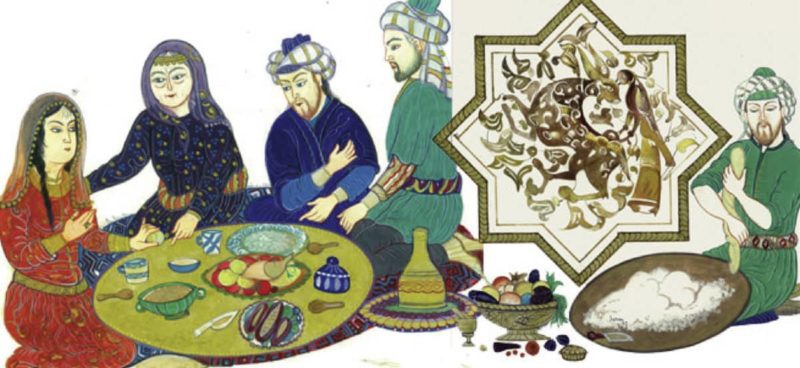
Meats were served whole and were extremely tender and could be torn into pieces for consumption. Vegetables and side dishes were served alongside the meats. Wine and sherberts were served for beverages although a more alcoholic drink was available due to religious reasons was not served in every household.
Turkish food is also not particularly spicy as it is a combination of Middle Eastern, Central Asian, and Balkan cuisines and of course the history and tradition of the Ottoman Empire.
Turkish food is somewhat difficult to quantify. You have what appears to be Greek and Cypriot meze stuffed vine leaves, Hummus and grain pilafs, and sweet items like Baklava. Mediterranean tomatoes, olives and olive oils, rosemary and other Mediterranean herbs and spices. Asian influences from yoghurts and vegetables such as Japanese eggplants and of course sesame oil and seeds.

Traditional Turkish Foods to Try
1. What are some traditional Turkish foods that one must try?
Turkey has a rich culinary tradition that offers a wide variety of delicious dishes. Some traditional Turkish foods to try include lahmacun (Turkish pizza), dolma (stuffed vegetables), kebab (grilled meat), baklava (sweet pastry), and çiğ köfte (spicy meatballs).
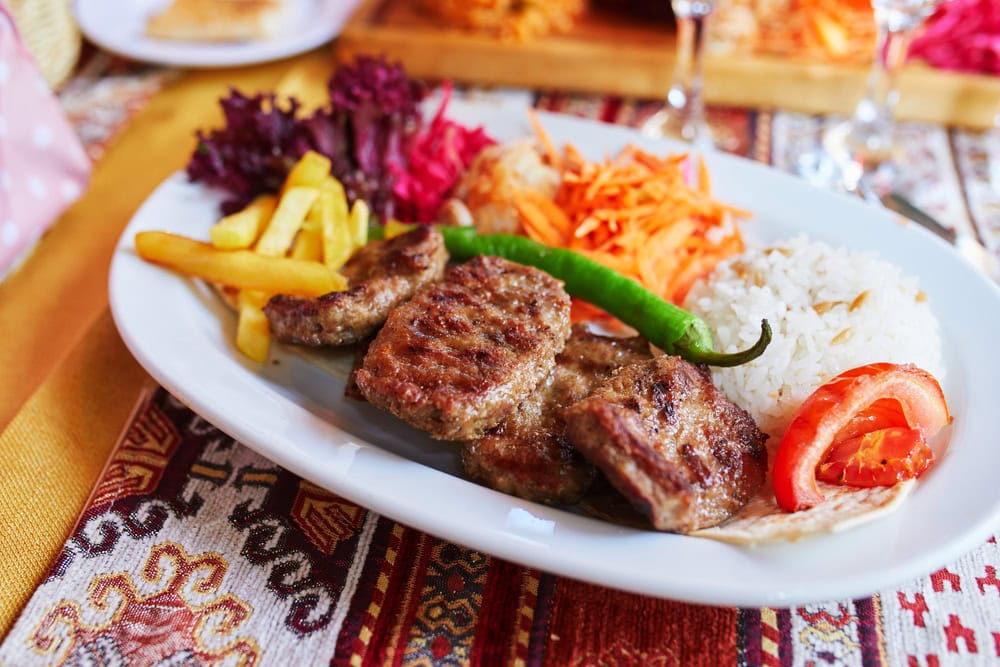
2. What is a typical Turkish breakfast like?
A typical Turkish breakfast consists of olives, cheese, tomatoes, cucumbers, bread, jam, honey, and tea. Turkish breakfast is known for its variety of flavors and textures, often including a selection of freshly baked pastries and borek.
3. Can you recommend some popular Turkish street foods?
When in Turkey, be sure to try sis kebap (skewered meat), midye dolma (stuffed mussels), simit (sesame bread rings), turşu (pickled vegetables), and balık ekmek (fish sandwich). These street foods showcase the vibrant and flavorful cuisine of Turkey.

4. What are some traditional Turkish desserts that are a must-try?
Traditional Turkish desserts that are a must-try include künefe (sweet cheese pastry), lokum (Turkish delight), sütlaç (rice pudding), şekerpare (sweet pastries soaked in syrup), and revani (semolina sponge cake).
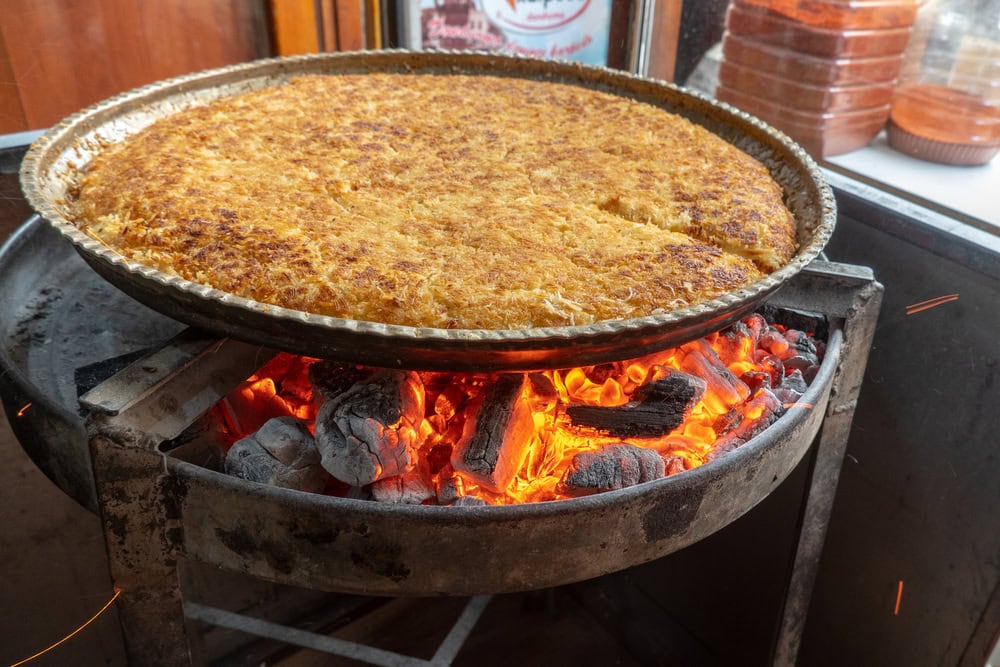
5. How is Turkish coffee different from regular coffee?
Turkish coffee is a strong and rich coffee prepared by boiling very finely ground coffee beans with water and sugar in a special pot called a cezve. It is traditionally served unfiltered, resulting in a thick and intense coffee experience.
6. Are there any vegetarian options in traditional Turkish cuisine?
Yes, traditional Turkish cuisine offers a variety of vegetarian and vegan foods.
Is Turkish Food Spicy (hot)?
This really depends on the region of Turkey you are visiting. For the most part, no – Turkish cuisine is a melding of spices and herbs but not particularly hot and spicy.
There is however a very traditional Turkish pepper paste that is used in many dishes but again not very “hot”. The pepper paste is called Biber salçası and in many Turkish recipes, you will see it simply referred to as paste. Do not substitute tomato paste. It is a sun-dried variety of locally grown red pepper that ranges from mild to hot. This paste must be cooked to produce the depth of flavour found in many Turkish recipes that use it.
Another favourite snack of the Turks is the pickled hot green peppers found in virtually all stores and street stalls. The peppers range in depth of heat from fairly mild to super hot so beware.
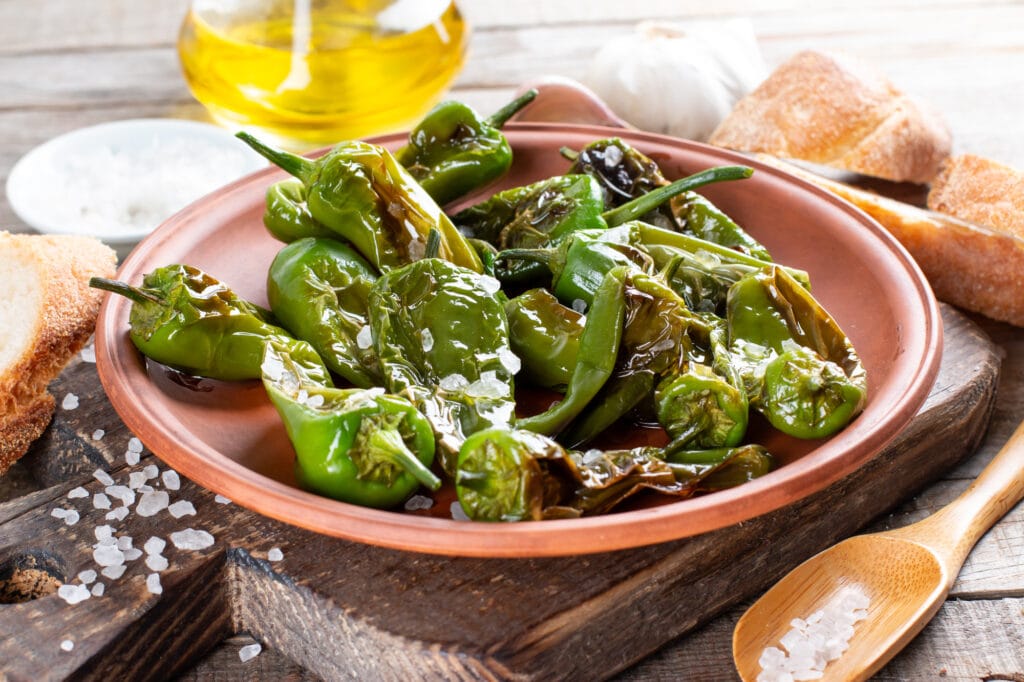
To really appreciate Turkish Food your Istanbul itinerary must include a culinary walk. On this tour, you will take a ferry and visit different shops at Kadiköy Istanbul including the fish market and try some tastes of traditional Turkish food. Try a typical delicatessen, muhallebi or baklava. Then, enjoy a main course at the famous Çiya Restaurant with delicious flavours and hang out at a typical Turkish coffee house. Lastly, ferry back to Karaköy, where your guide can give you helpful tips for the rest of your time in Istanbul.
Traditional Turkish Tea
Turkish tea is a ritual and an important part of Turkish culture. Tea is more commonly drunk here even though Turkish coffee is known throughout the world.
Turkish tea is prepared using two stacked kettles called “çaydanlık”. In the larger kettle on the bottom the water is boiled and then used to fill the small top kettle. Loose black leaf tea leaves are added and the water is infused with tea which becomes quite strong.
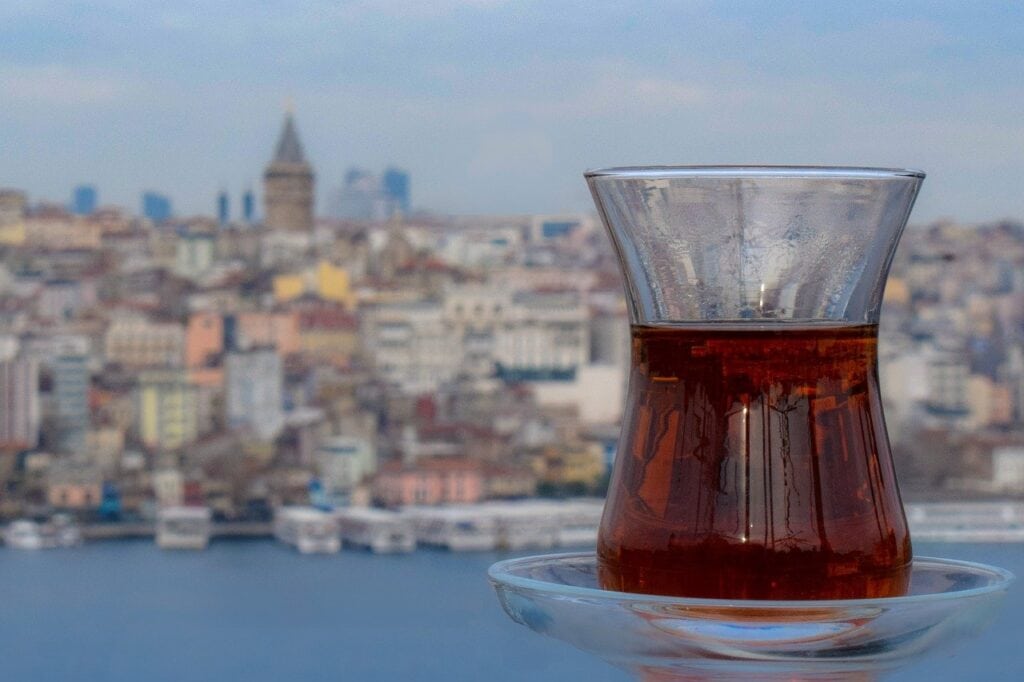
When you are served the tea the water in the bottom kettle is then used to dilute the tea depending on how strong you want it. You will be offered koyu, which is dark or tavşan kanı, which means rabbit’s blood as black tea is actually a dark red in colour and weak açık. Tea here is never taken with milk but it is sweet from the addition of sugar cubes and drunk from small clear tulip-shaped glasses.
Turkish Coffee
Coffee is an integral part of the culture in the Middle East, and Turkey is no exception. Coffeehouses were first opened in the capital over 500 years ago, and now you can find one in all the neighbourhoods in Istanbul. Turkish coffee uses finely ground coffee beans which are boiled with sugar and cardamom in a small coffee pot called a cezve.

The coffee is served in small cups and, as the coffee is unfiltered, it usually sits for a couple of minutes before it is served. This allows the grounds to sink to the bottom of the cup. There’s usually a thin layer of foam on the top of the coffee, and you usually drink it black without cream or milk. If you have a sweet tooth, you can add more sugar. Just remember not to drink the last sip, as the grounds aren’t pleasant to drink. And, in some regions, people believe that you can tell your fortune from the coffee grinds left in the cup. Contributed by Roxanne of FarAwayWorlds.
What is Turkeys’ National Dish?
Manti is one of the classic Turkish dishes that most people consider Turkey’s National Food. There is however no limit to delicious Turkish food as long as you are willing to try the local authentic Turkish cuisine.
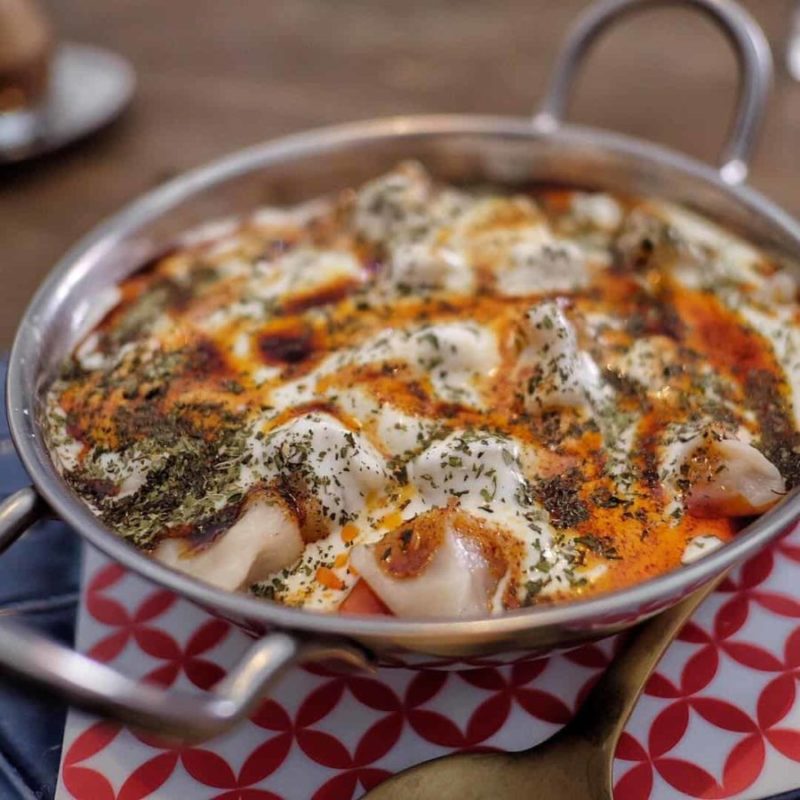
This is a dish that some say reminds them of ravioli. Manti is, however, very different. The little dumplings are stuffed with fillings consisting of either beef or lamb and then fried or boiled. The meat is, according to a 15th Century Ottoman recipe, flavoured with simple seasonings it is the condiments that are served with Manti that make it special. There are various little dishes to spark up the Manti and they range from spicy red pepper to yoghurt, mint, crushed garlic, sumac and melted butter.
If you want to explore Turkish food further and see how the locals cook and eat why not take a Private food and culture tour in Ayvali Village. Try Turkish life with a family meal and an evening mingling with locals at some of their favourite places on this Cappadocia food tour. An expert local guide will meet you at the meeting point, from which you’ll wander through the streets of historical Sultanahmet en route to meet a local family.
What are traditional Turkish foods?
Traditional Turkish food is a combination of fresh vegetables including eggplant (aubergine), salads, tomatoes, nuts and fruits, olive oil, Mediterranean spices and herbs.
Some of the most popular foods include minced meat dishes like kebabs, kofta, and of course desserts such as Baklava.
Meats used for the most part in Turkey include lamb, beef, buffalo, chicken and other game Birds.
38 Turkish foods to try when visiting
Turkish Meze
Meze is served all over this region of Europe. From Cyprus to Greece and Turkey Meze are a selection of small tastes of many dishes. The selection of Mezes includes hummus, yoghurts, fresh flatbread bread, kofte (meatball), dolmas (rice stuffed vine leaves) and eggplant salad among other local favourites. Mezes is a very traditional Turkish dinner.
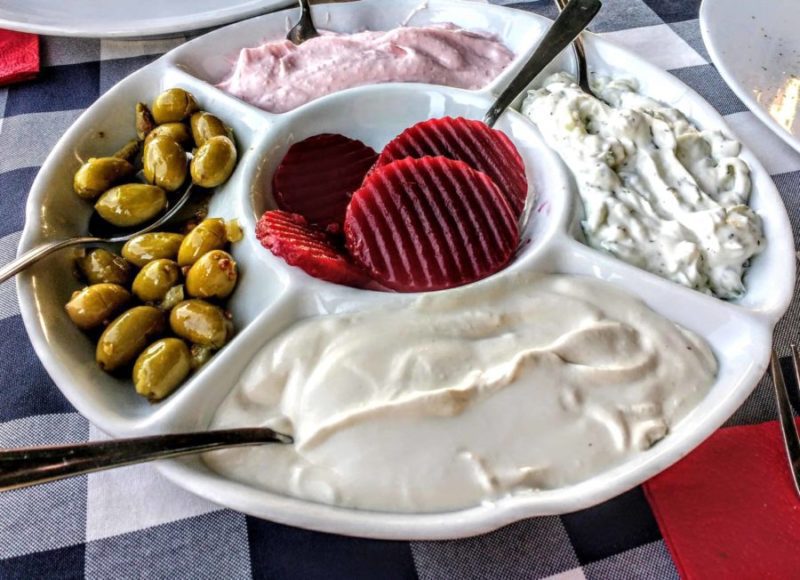
Mezes are great because it allows you to taste many dishes, but beware it can get expensive and expansive as Meze meals can consist of up to 30 small dishes.
What is a Turkish breakfast?
Most Turkish breakfasts start with tea, although Turkish coffee is well known throughout the world it is a tea that is preferred here for breakfast.
A traditional Turkish breakfast includes white cheese which is quite similar to feta cheese, soft white bread, old cheeses known as kaşar peyniri, honey, butter, jam, boiled eggs or an omelette all of which is served with tomatoes, olives and cucumber.
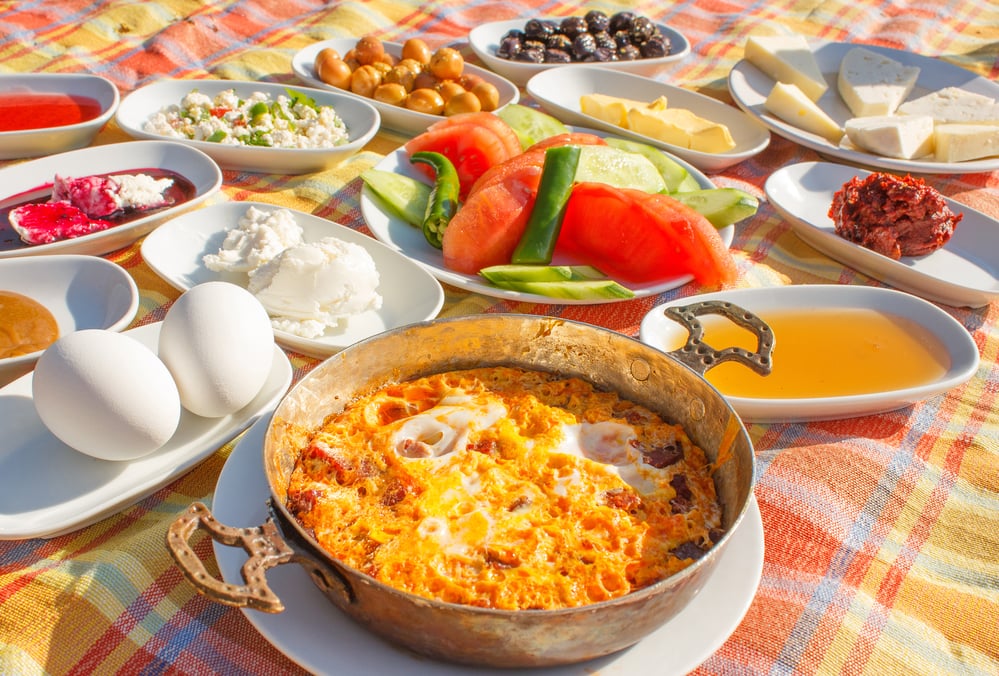
Sucuklu Yumurta
A Turkish breakfast favourite is sucuk which is cooked in a pan and contains mainly eggs (sucuklu yumurta) and the famous Turkish sausage Sucuk. This is a dried sausage that is made with ground beef mixed with red pepper, cumin, garlic and sumac. The sausage can be a little spicy depending on the maker and is a bit similar to Chorizo in Spain.
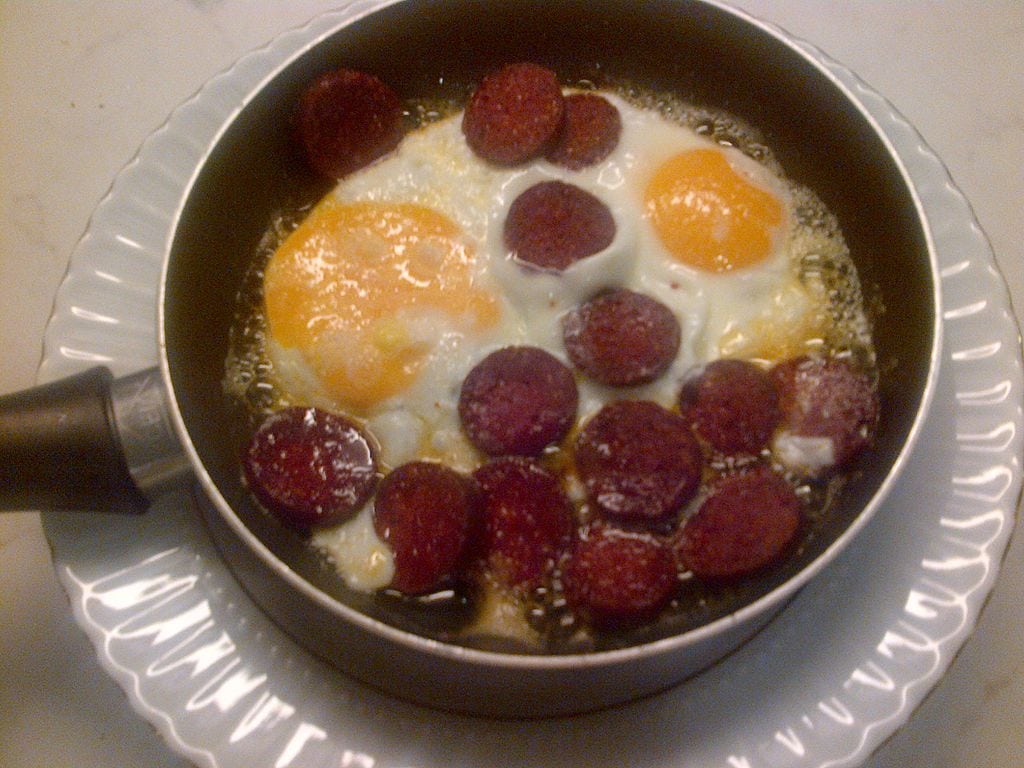
Kahvalti
In Turkey, Kahvalti literally means “before coffee” and it is a “continental breakfast” to beat all. Almost a breakfast meze the Kahvalti includes dozens of little dishes from fresh sliced tomatoes, olives, cucumbers, and cheese, kaymak (clotted cream) and honey. Kahvalti can include small börek (filo pastry) or simit (sesame bagel) and of course, çay (tea) coffee or kahve won’t be served until the meal is finished.
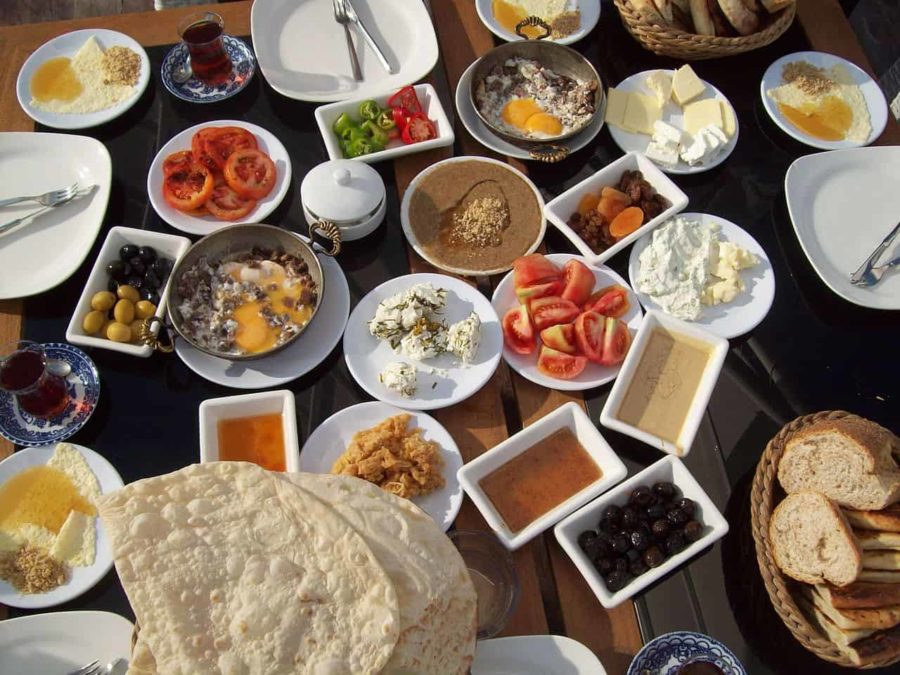
Menemen
Another great Turkish breakfast dish Menemen or Melemen is a scrambled egg dish that is cooked with stewed tomatoes and peppers. Similar to Shakshuka but with scrambled eggs.
The eggs are very soft and soupy and it is served with a soft puffy flatbread to sop up all the flavours.
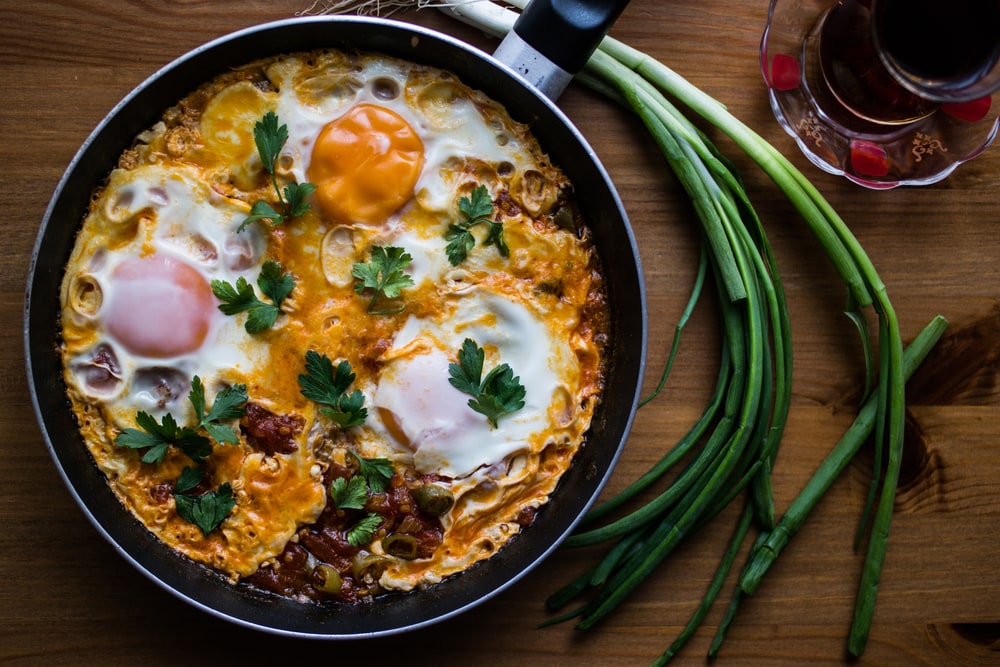
Turkish Street Food
Kokoreç
Kokoreç is a marinated dish, made with either lamb or goat intestines that are then wrapped around seasoned offal. This sausage-shaped meat is then slowly grilled and then chopped and served. Sprinkled with salt, oregano or some spicy chiles this is true Turkish Street Food and is found everywhere in Turkey. You eat it stuffed into soft pillowy white bread to make a portable snack. This may convert you to nose-to-tail eating.
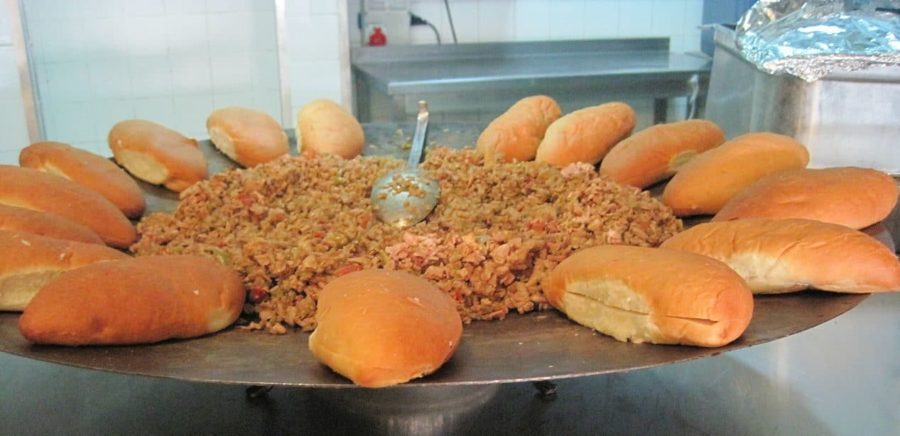
Simit
Turkey’s answer to the doughnut and somewhat similar to a bagel a Simit is a freshly baked sesame-crusted bread. Unlike bagels, though it is not boiled but baked and dipped in molasses and then topped with sesame seeds, this is a favourite of Turks for a portable breakfast.
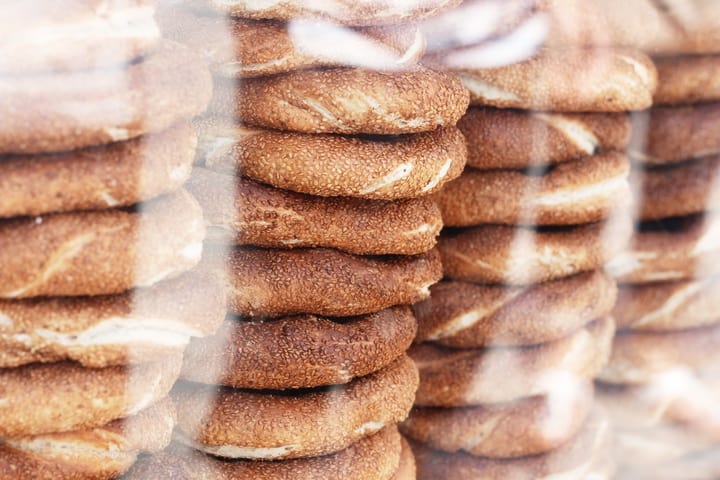
Famous Turkish fish sandwich – Balik-Ekmek
If you are a fan of TV travel shows you will have undoubtedly seen those rocking boats on the Bosphorus in Turkey serving up gorgeous fresh fish sandwiches on beautiful crusty bread. This is my idea of absolute foodie heaven – what could be better than my favourite street food, served beside an ancient waterway from a boat that is constantly moving?

One of the most famous Turkish dishes is the balık-ekmek or fish sandwiches are found served up along the Bosphorus shore. This iconic grilled whitefish is served with raw onions, and lettuce, and seasoned with salt, herbs, and spices with a squeeze of lemon.
Lahmacun
This appears to be a pizza, and it is quite similar but done with a typical Turkish flair. A very simple meal of flatbread that is quite thick and topped with minced beef that is flavoured with onion, tomato sauce and red pepper. Popped into a wood-burning oven and cooked for a few minutes lahmacun is a very uncomplicated lunch or snack.
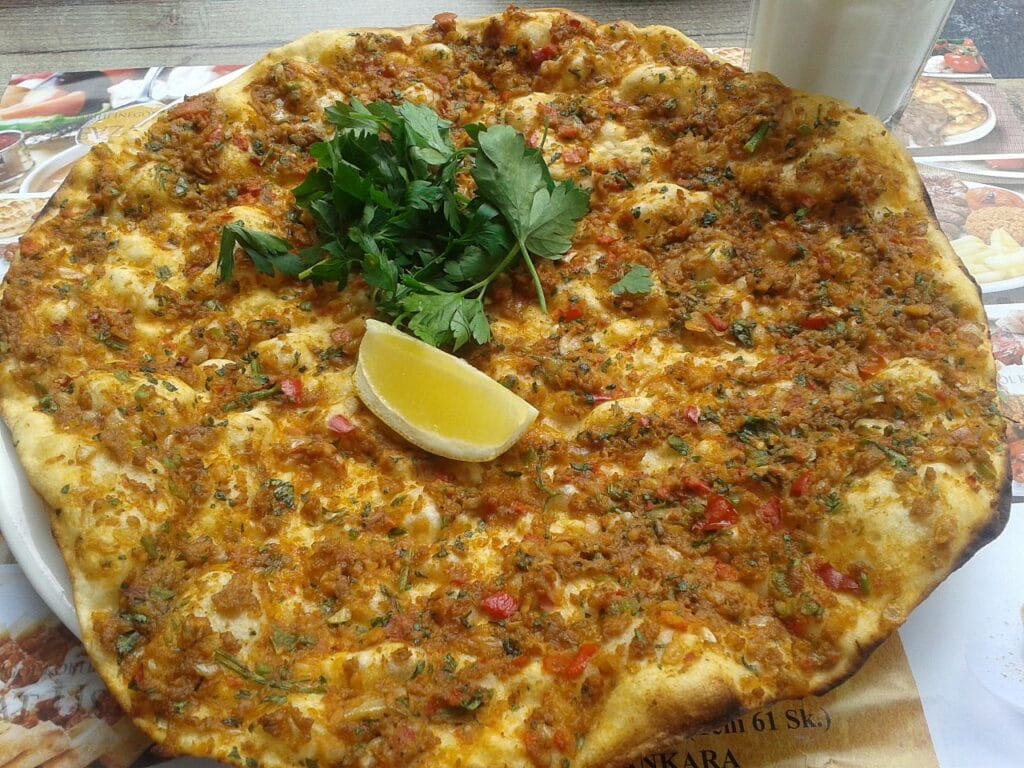
When it arrives you simply top it with parsley, lettuce and lemon juice, roll it up and wash it down with a glass of cold ayran (a salty yoghurt-based drink. You can also ask for a kaşarli lahmacun, which is the same just with some melted cheese.
Dürüm
Dürüm is one of those Turkish dishes that you will find on street food stalls and fine dining tables. This beautiful wrap sandwich comes in vegan, vegetarian and meat-lovers versions. Dürüm is the Turkish word for a wrap and is normally some sort of meat and vegetables rolled inside a thin bread called Lavaş (lavash). Makers of Dürüm are known here as dürümcu, Turkish for the wrap-making profession. The bread or lavash must be sturdy, thick enough to contain all the dripping juicy bits but light and chewy – I’ll leave the taste to your imagination.
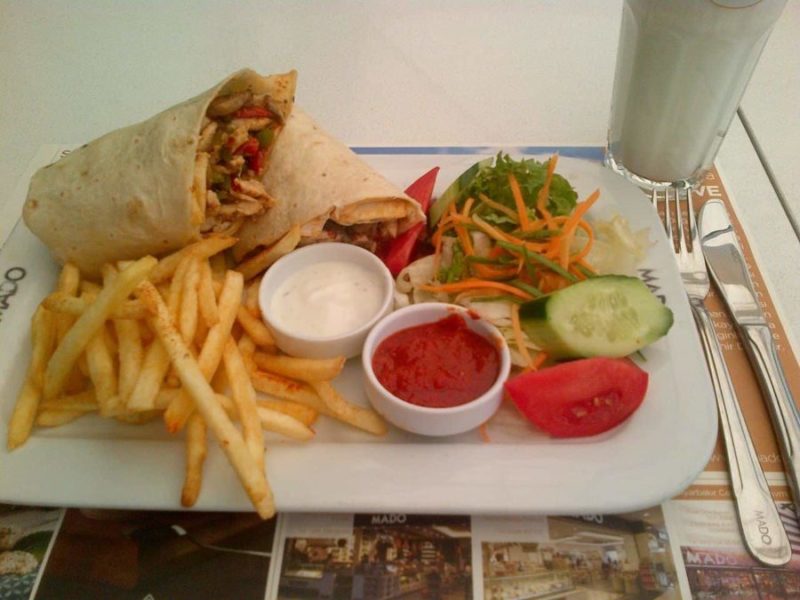
Tantuni
This is a close relative of the dürüm, but tantuni is usually beef, tomatoes, peppers and a heaping of spices both really hot and not so hot depending on your taste buds. This is then wrapped in the thinnest of flatbreads. For traditionalists, it is not the real “thing” unless it burns when you eat it. One of the best places to get authentic tantuni in Istanbul is Emine Ana Sofrası on Billurcu Sokak in Taksim.
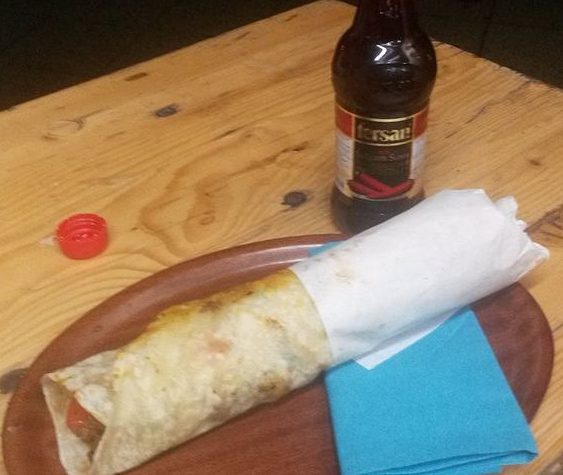
Midye dolma
More of a snack, particularly for those out in the evening, than a meal, midye dolmas are mussels served in the shell, mixed with spicy rice and served with a squeeze of lemon juice. They are served on every street corner in Taksim at night. When eating midye dolma from the stall you keep eating as many as the seller gives you until you feel full and can’t eat another.
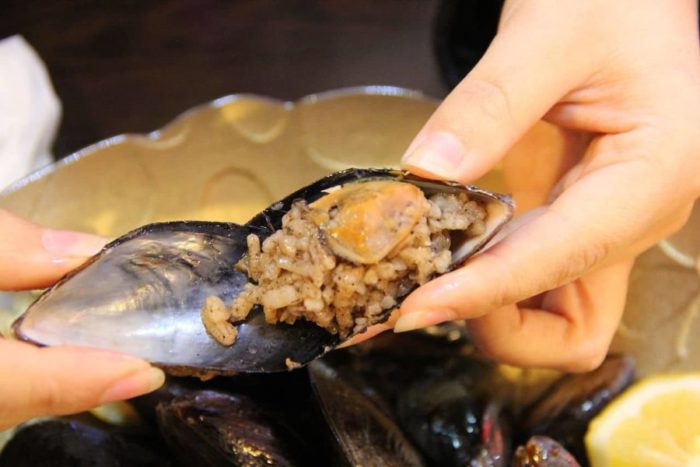
Kumpir
A baked potato by any other name and stuffed at that. A selection of toppings that range from kaşar cheese, corn, mayo, salad, peas and carrots, the potential combinations are off the charts.
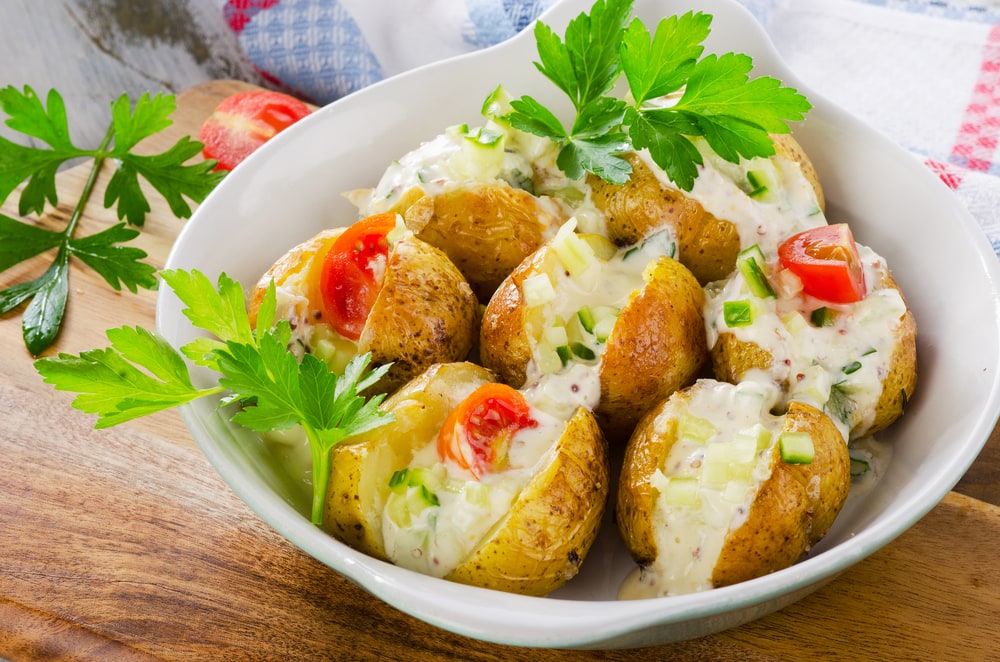
Tavuk Pilav
In Istanbul, my favourite street food is chicken and rice. Served and eaten for lunch by almost everyone this chicken and rice dish is brought to you by a huge number of vendors who serve it from glass-covered carts all over the city.
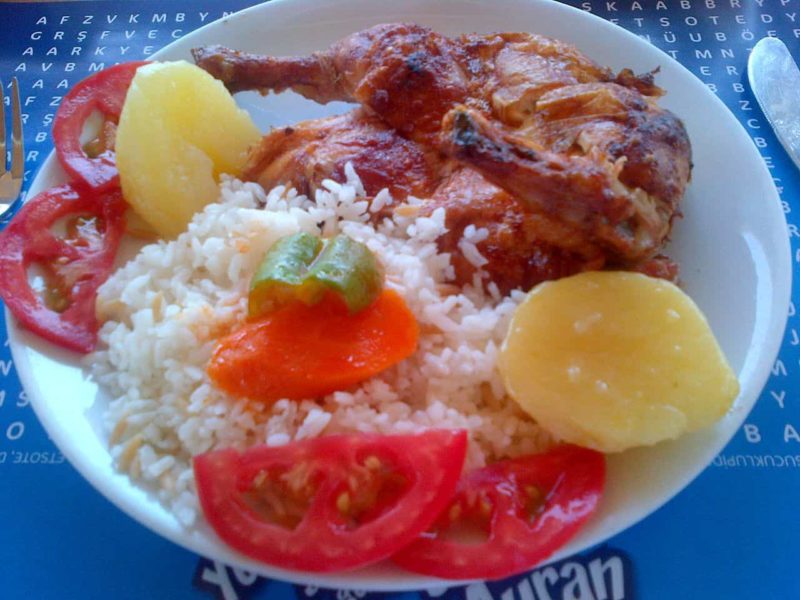
The rice is plain white rice but it is cooked with a good oil or butter with thyme, pepper, cinnamon cumin and almonds. You can enjoy a vegetarian version with no chicken and vegetables like eggplants, carrots, tomatoes, peppers and chickpeas are added.
Börek
One of my favourite foods to eat in Istanbul I do love a Börek and have eaten many kinds of them all over the world. The most popular Turkish Börek is a cheese version that many eat here for breakfast but more interesting Böreks can be found in many a restaurant. A super-thin dough, almost like filo but called yufka is wrapped in a sausage shape and then curled around into a hand-sized pastry. The light chewy dough encompasses either cheese or meat type of filling that is quite delicately flavoured.
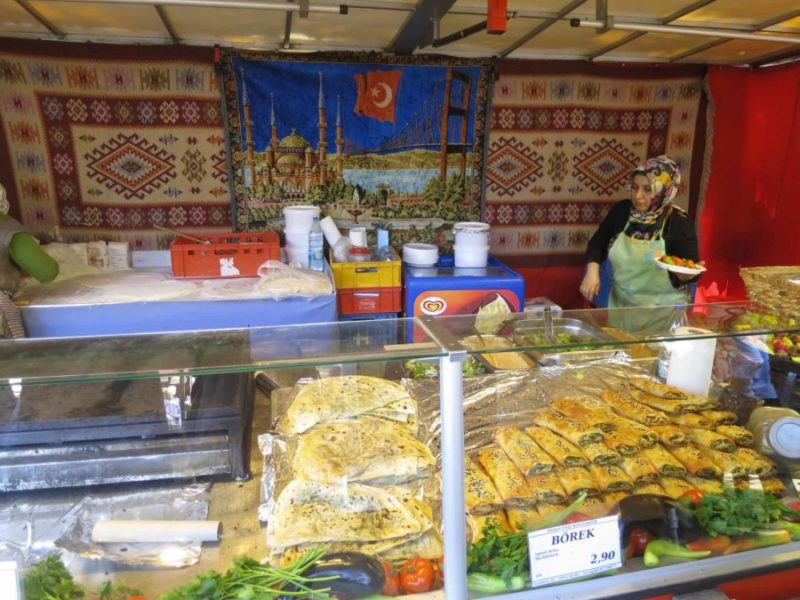
Other traditional boreks include – Su böreği made with boiled yufka and layered with cheese and parsley. Çiğ börek is fried and stuffed with minced meat. Other traditional Turkish böreks include Talaş böreği in which a phyllo dough is wrapped around diced meat and vegetables.
Famous Turkish Wet Burger
A wet burger is quite famous in Istanbul it looks awful a soggy bun with some meat tucked inside but is absolutely delicious. The bun is soaked in tomato and garlic sauce and it is a street food favourite.
Get your taste of a “wet burger on this tour which is full of delicious culinary exploration! The first taste is a ‘’Wet Burger,’’ followed by a visit to the Hacibekir Sweet Shop, open since 1777, to taste the best Lokum (Turkish Delight) and colourful “Bonbon Turc.”
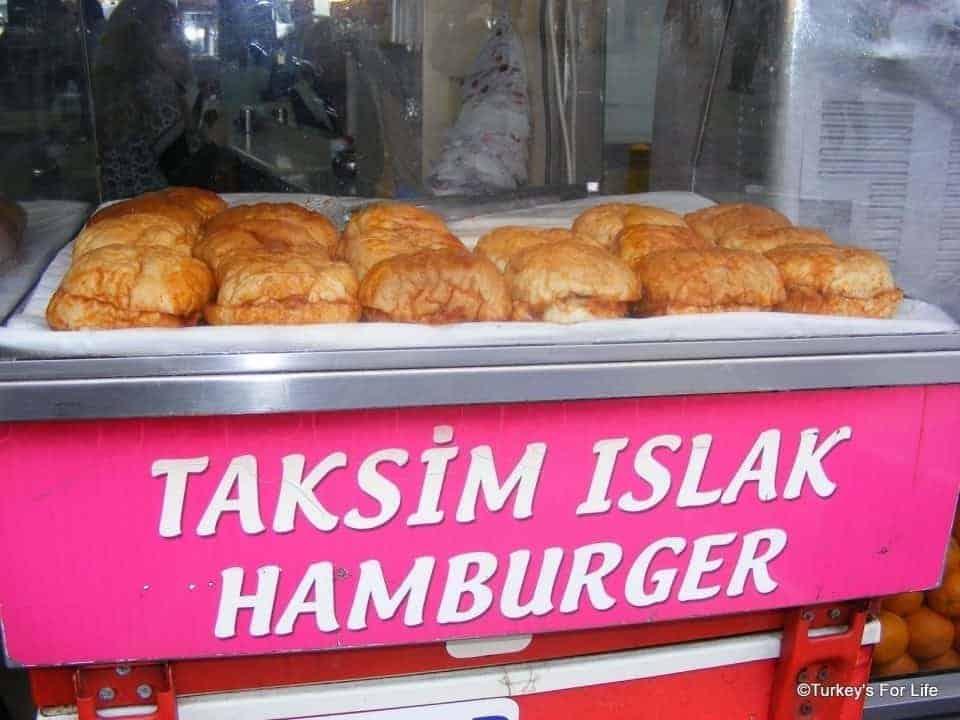
Explore the uncharted side streets of Pera, the cultural heart of Istanbul. Taste kebap wraps at Dürümzade famed by Anthony Bourdain. Go through Hazzapoulo Passage for Turkish coffee and watch “coffee fortune-telling.” Visit a typical Meyhane (Turkish Tavern) to enjoy the Turkish Meze and Turkish Raki.
Turkish Food favourites
Kofte
You simply cannot go to Turkey and not try a Kofte. You have probably seen them in your travels or even had them at home. A Kofte is a staple food of the Turkish diet and there are all kinds of varieties from meat-based to completely vegan.
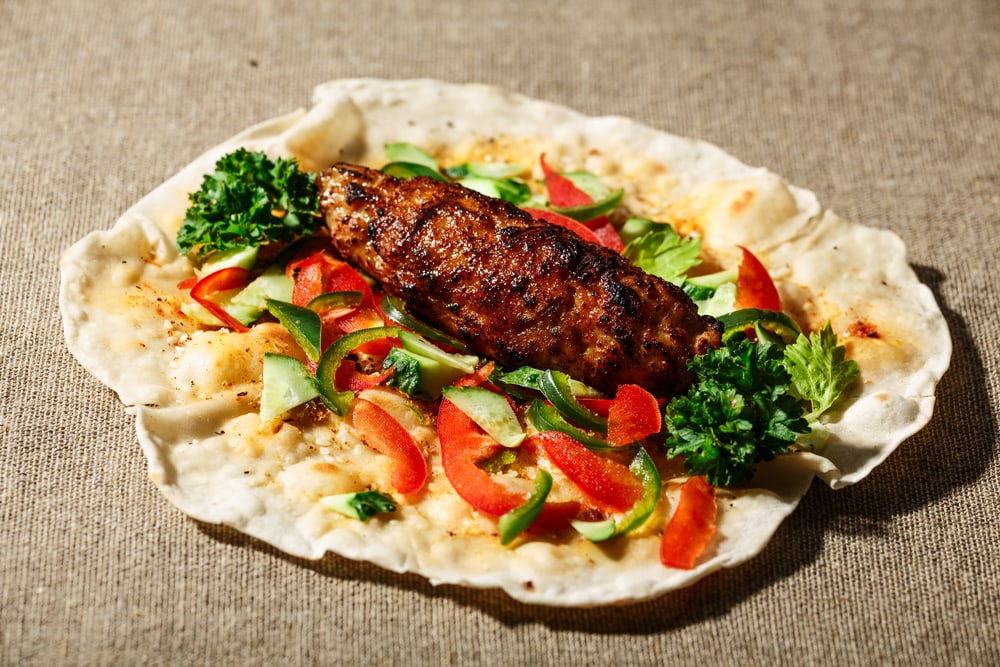
Vegetarian & Vegan Kofte
A Kofte is essentially a flattened patty or meatball-shaped dish made of ground meat such as beef or lamb or vegetarian and vegan varieties. These are usually chickpeas and vegetables or cooked red lentils and bulgur wheat, spiced and shaped into patties. Vegetarians can try mercimek koftesi. Which are the red lentils and bulgur version combined with spices and herbs and made into a patty shape.
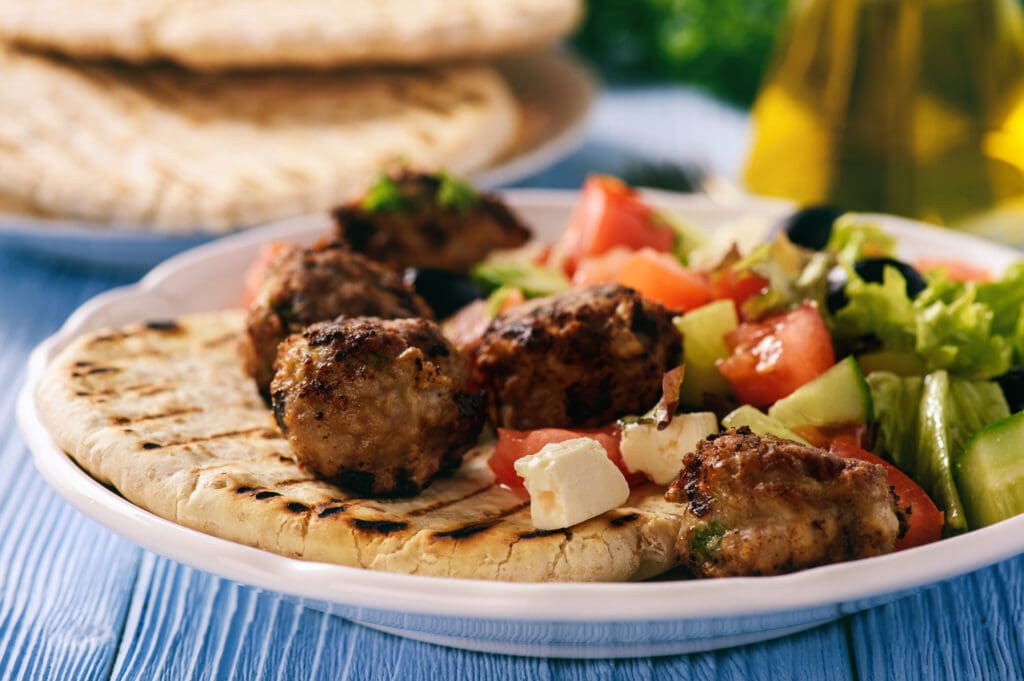
Izmir Kofte
Kofte is also served in a casserole or one-pot dish called Izmir kofte. You will find a huge variety of Kofte and as street food, they are served either in a pita or the patties are served with a yoghurt topping.
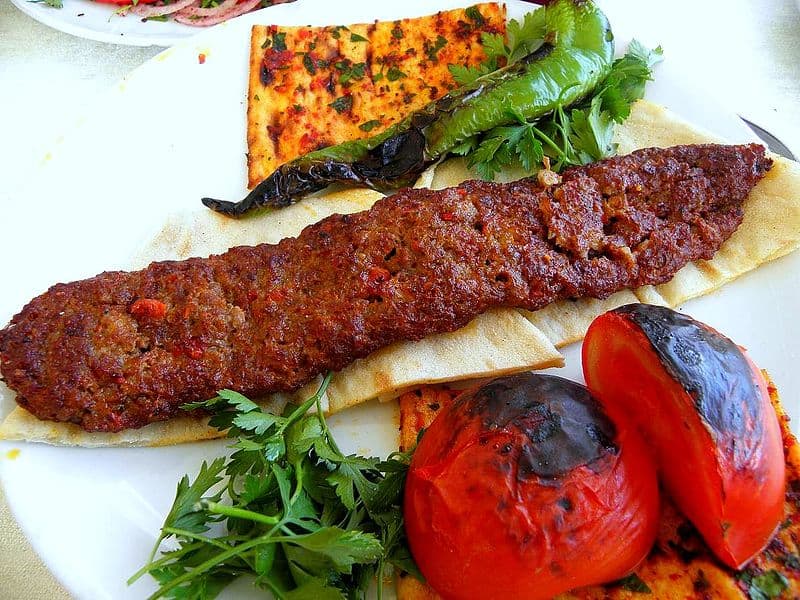
Çiğ köfte
Çiğ köfte is the bulgur wheat version made with bulgur, peppers, tomato puree, onion, and Turkish herbs and spices. The balls are shaped into a sphere, cooked and served in a lettuce leaf. This is a great vegetarian and vegan dish.
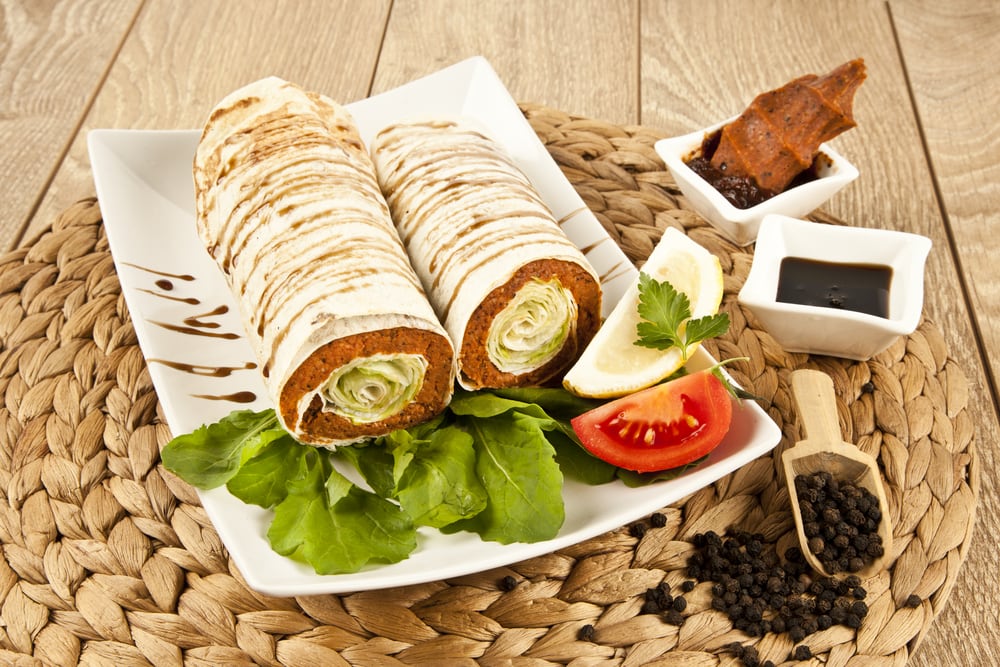
Hunkar Begendi
One of the most delicious Turkish dishes you will try is Hunkar Begendi. The simple ingredients include a smoked and spiced pureed eggplant that is first grilled and then pureed with milk, butter and roasted flour. This tasty mixture is then topped with a lamb stew blend and it is known as Sultan’s Delight.
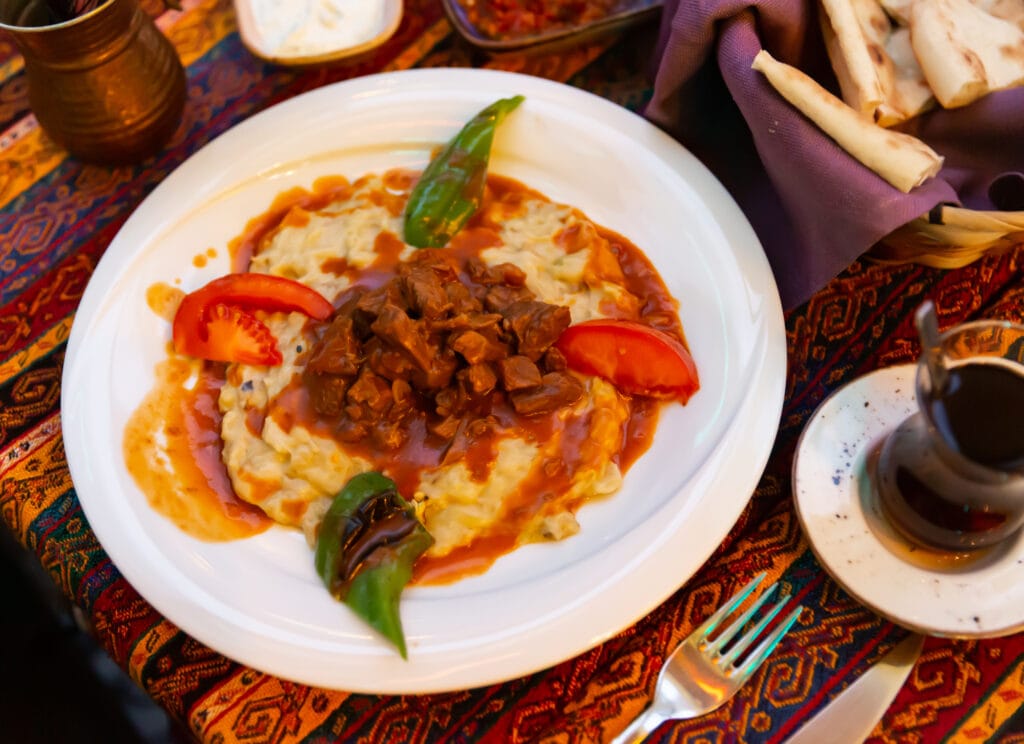
Turkish Soups
Lentil Soup- Mercimek Corbasi
Most European cuisines feature soups and Turkey is no different. Here they serve a very simple but filling lentil soup called “Mercimek Corbasi”. This is a soup that is gentle on digestion as it is served from pureed lentils flavoured with homemade stock and fresh herbs and spices. The soup is served with garnishes of cilantro, and fresh lemon and eaten with some fabulous soft, fresh pillowy pita bread.
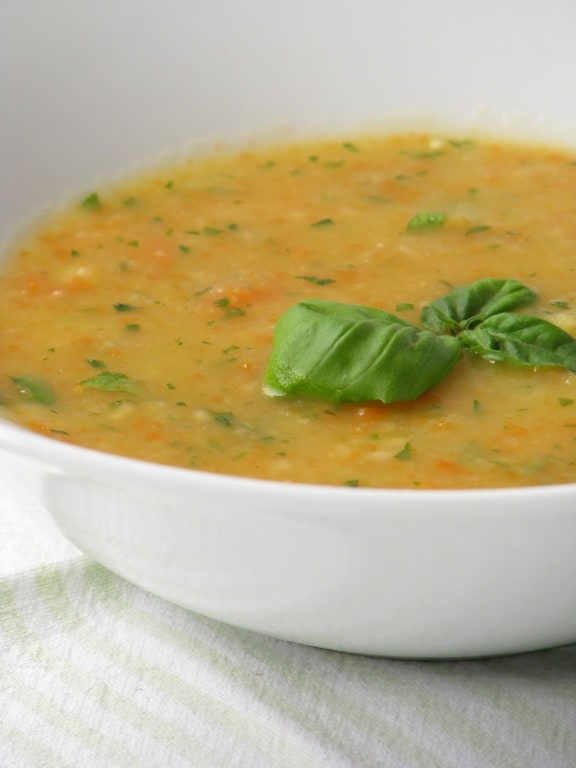
Corba Soup
A very simple tomato-based soup it can be served with sheep brain or tongue soup for the more adventurous eaters.
Şiş Kebap
Turkish seekh kebab we call them Shish Kebabs or Kebobs in the west. Kebabs were invented in Turkey and here they come is lamb, beef or even fish versions. A simple dish of skewered meat or fish cooked over charcoal and served with yoghurt is a must-have Turkish dish and one of the best Turkish dishes you can eat while walking around Istanbul.
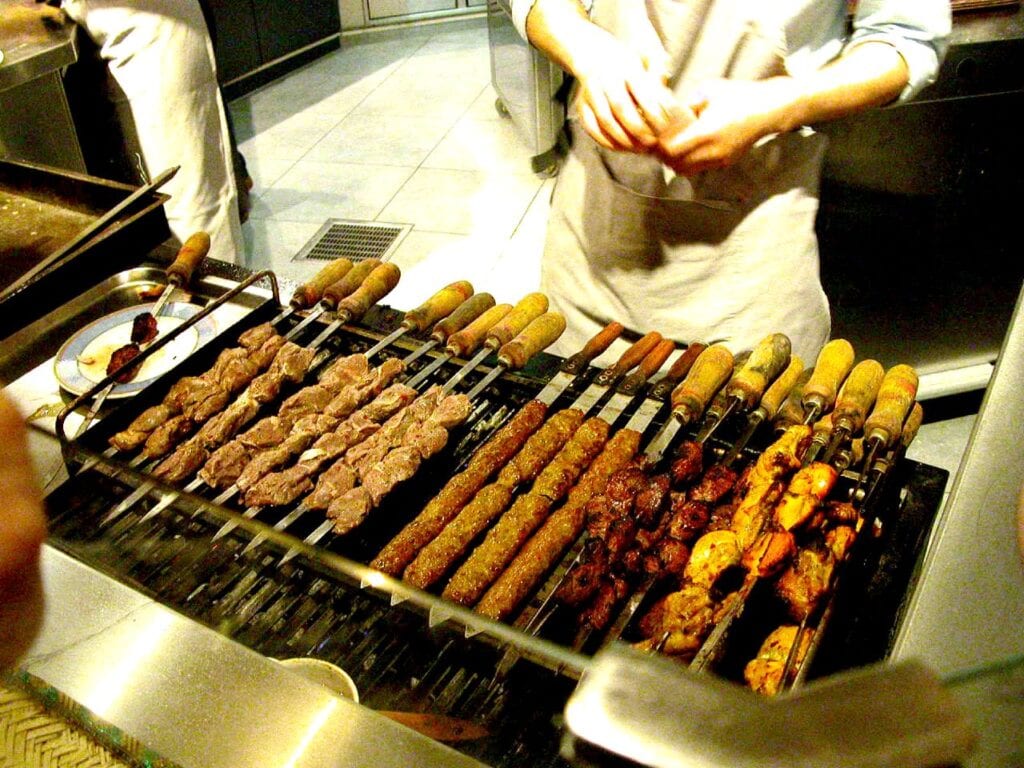
Döner
the most popular Turkish food dish is of course the döner kebap. In the West, we tend to call these Doner Kebabs and they are a favourite for those folks staggering home from the bar or pub.
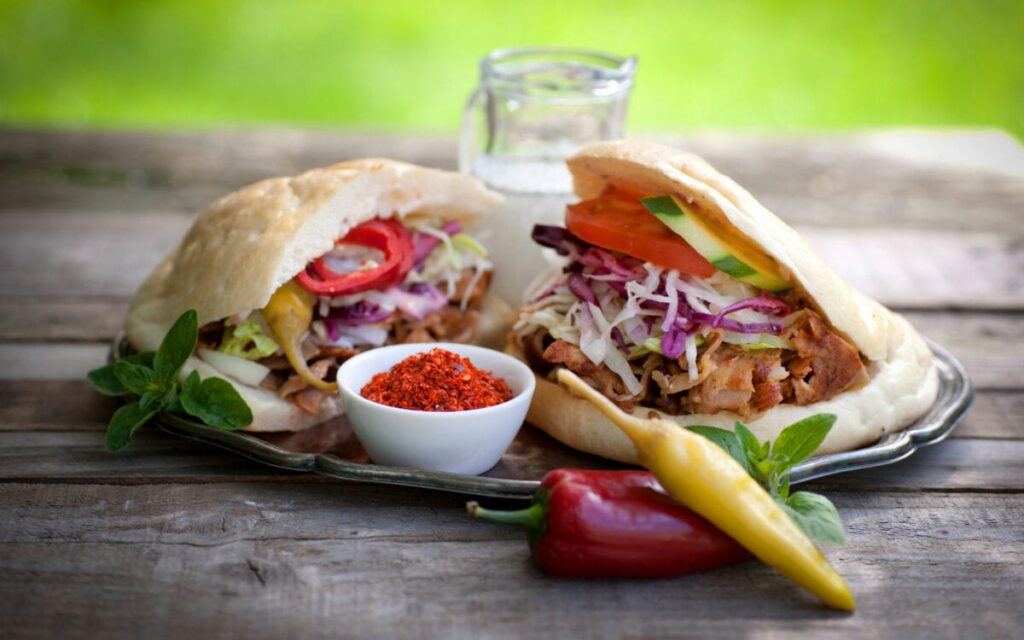
Döners are basically a sandwich made with beautifully slow-cooked chicken, pork or beef from an upright rotisserie. They are slow-cooked and the marinated meats drip with flavour. Served in a soft pita along with vegetables, pickles and a yoghurt sauce this is a taste treat.
Iskender Kebabs
An Iskender kebab is a speciality of Turkey. Long slow-cooked strips of lamb are served on top of rice in a pita The lamb is cooked in a tangy tomato sauce and served with a splash of lemon and some cooling yoghurt.
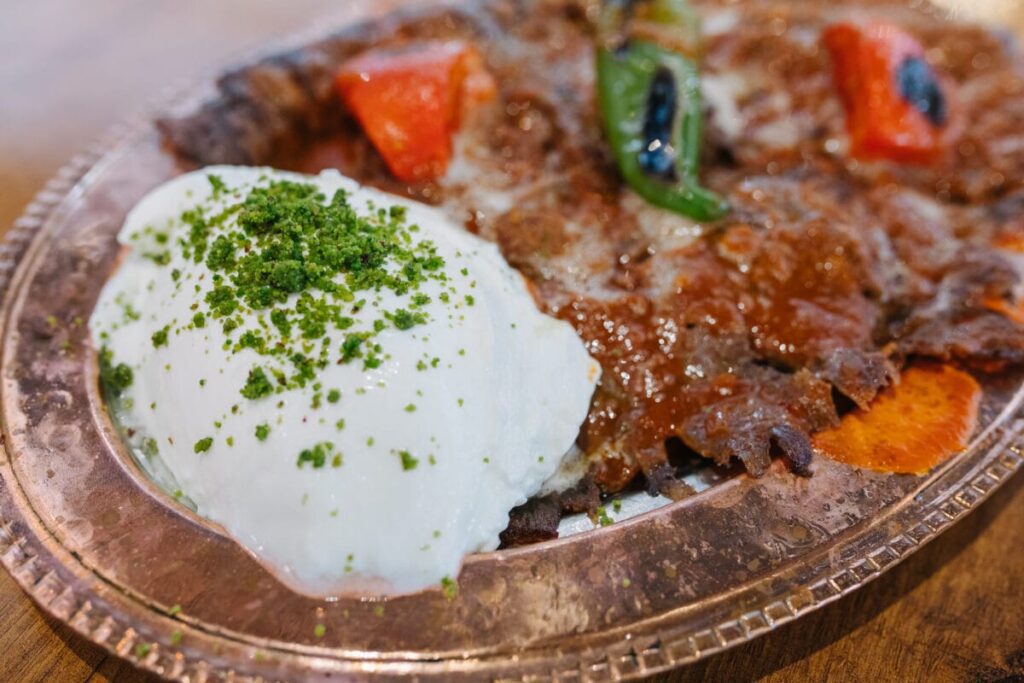
Yaprak Sarma
What is Turkish dolma? One of the best of Turkish traditional food is the Yaprak Sarma. This dish is known all over the Mediterranean (dolmades) stuffed vine leaves are a real treat either as a snack or part of a meze selection. The softened vine leaves are wrapped around a filling made of rice and onions which are flavoured with onion, mint, cinnamon, salt and pepper. These are quite time-consuming to make and so are saved for special occasions although you will find them everywhere in Turkey.

Turkish vegetarian food
Zeytin Yağlı Dishes – popular Turkish side dishes
Imam Bayıldi
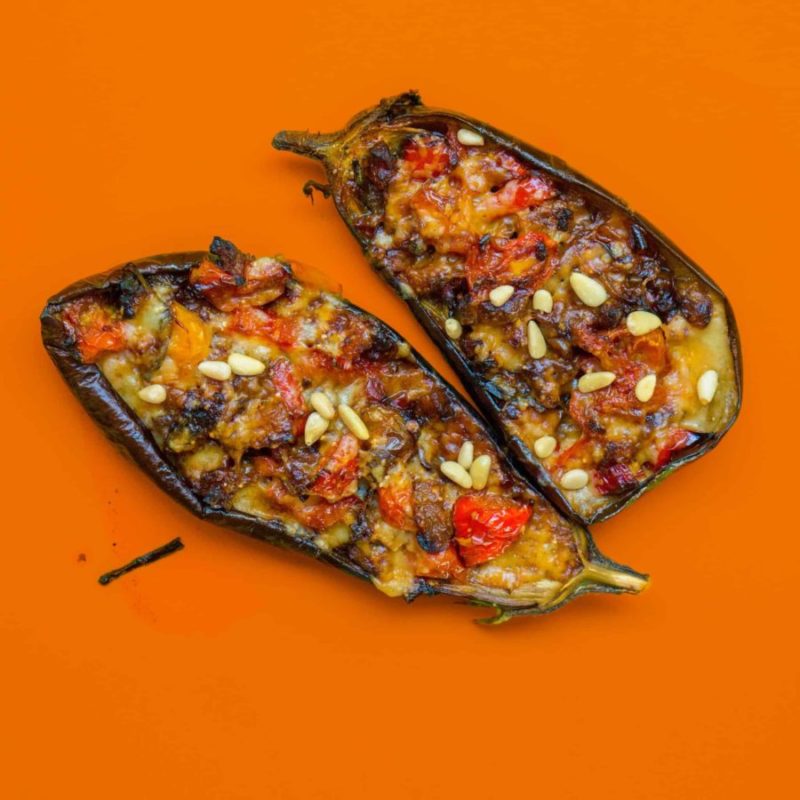
A brilliant dish for vegans is a stuffed eggplant. The filling is comprised of tomato, onion and garlic and rice or bulgur mixture then baked served with rice or bulgur pilaf.
In Turkey, if a dish is cooked without meat it is called zeytin yağlı. this means that it is usually served cold and is made with olive oil.
Taze Fasulye
This is a dish of green beans that has been cooked with tomato and onions.
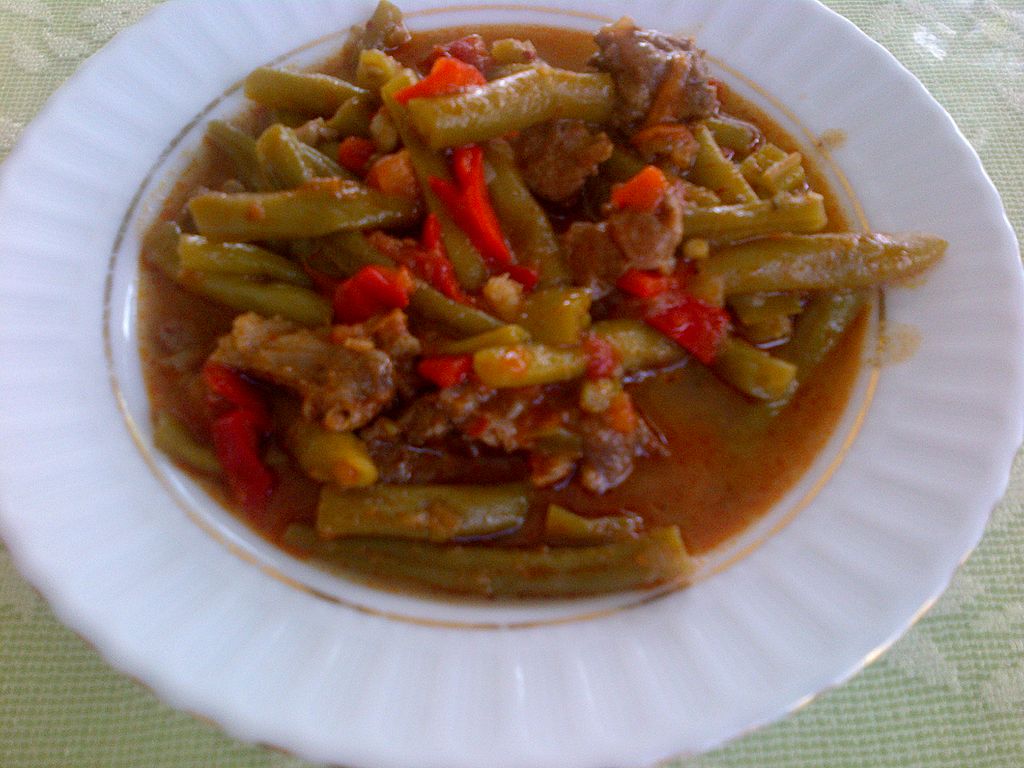
Mücver
This is a dish of grated zucchini, mixed with eggs and flour. Turks like to add white cheese, green onions and mint. This is made into a patty shape and then fried in olive oil and served hot.
Cacık
Similar to cucumber raita from India this dish is simply small diced or grated cucumber mixed with a thin yoghurt, garlic and mint.
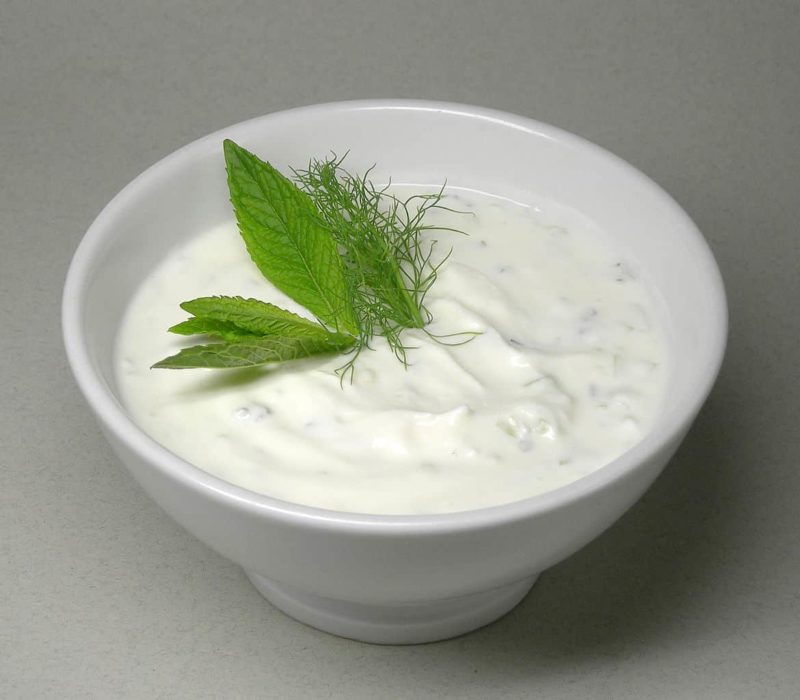
Types of Turkish bread
Turks love their bread and there are several flatbreads and loaves you can try in Turkey. The most popular is “somun ekmek” or “francala”, a fluffy white flour bread in an oblong-shaped loaf with pointed tips, rather similar to a traditional baguette.
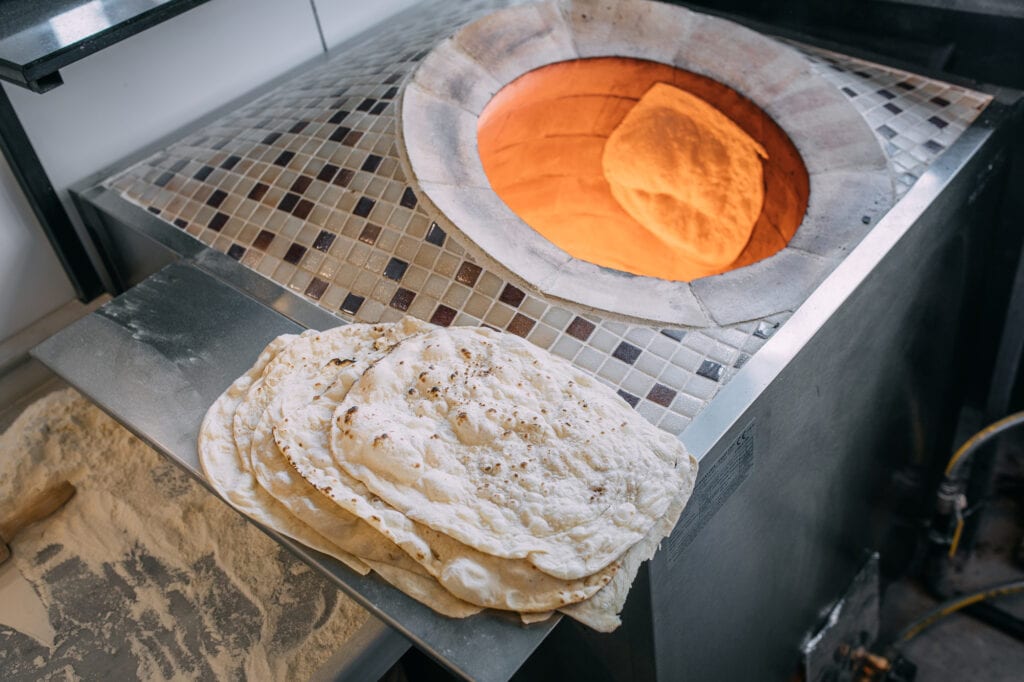
“Trabzon” or “tava ekmeği” is a sourdough loaf used for sandwiches. With Turkish flatbreads, there are two types Pide and Lavas. The “pide ekmeği” is not a pita bread though. It is a fluffy leavened flatbread baked in an oblong shape.
Lavash is the flatbread we most commonly associate with Turkey. It is an unleavened flatbread usually baked in a tandoori-style oven or flat stone in rural areas.
Traditional Turkish Desserts
Baklava
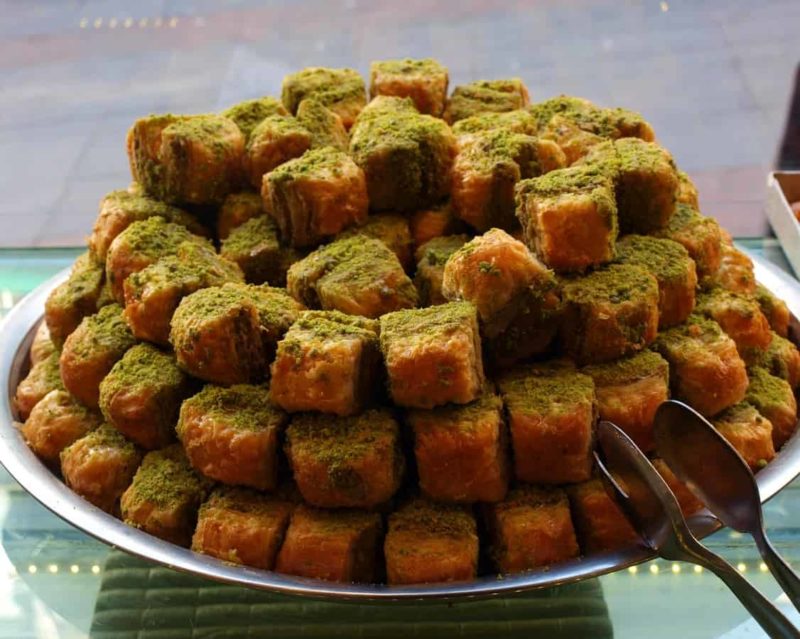
Probably the most famous food in turkey and an iconic Turkish dish Baklava is known throughout the world. One of the more popular Turkish desserts baklavas is a sticky, sweet filo pastry that layers filo, pistachios and other chopped nuts and is drizzled with oozing honey. So sweet it could melt your teeth Baklava is an international favourite.
Halva
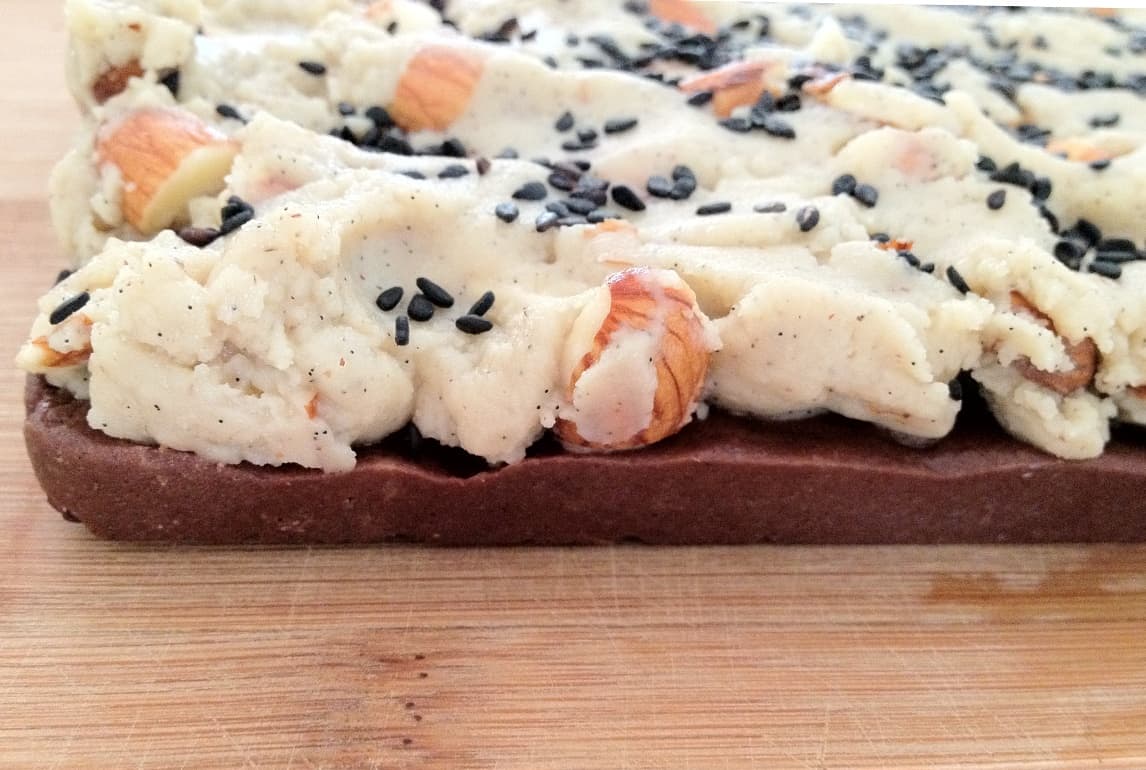
Turkish Halva is very different from halva you may have tasted before. Turkish halva is made from crushed sesame seeds or tahini and sugar and often pistachios are added.
Künefe Kadayif
Instead of phyllo dough, as it is used in Baklava, kadayıf is the main base of künefe. Kadayıf is thin fibres of dough, made from a mix of water and flour the Künefe is an unsalted cheese that is layered between the Kadayif and baked soaked in warm sweet syrup. The dessert is then topped with ground pistachios. There is also a walnut version in which ground walnuts replace the cheese it is called cevizli künefe.
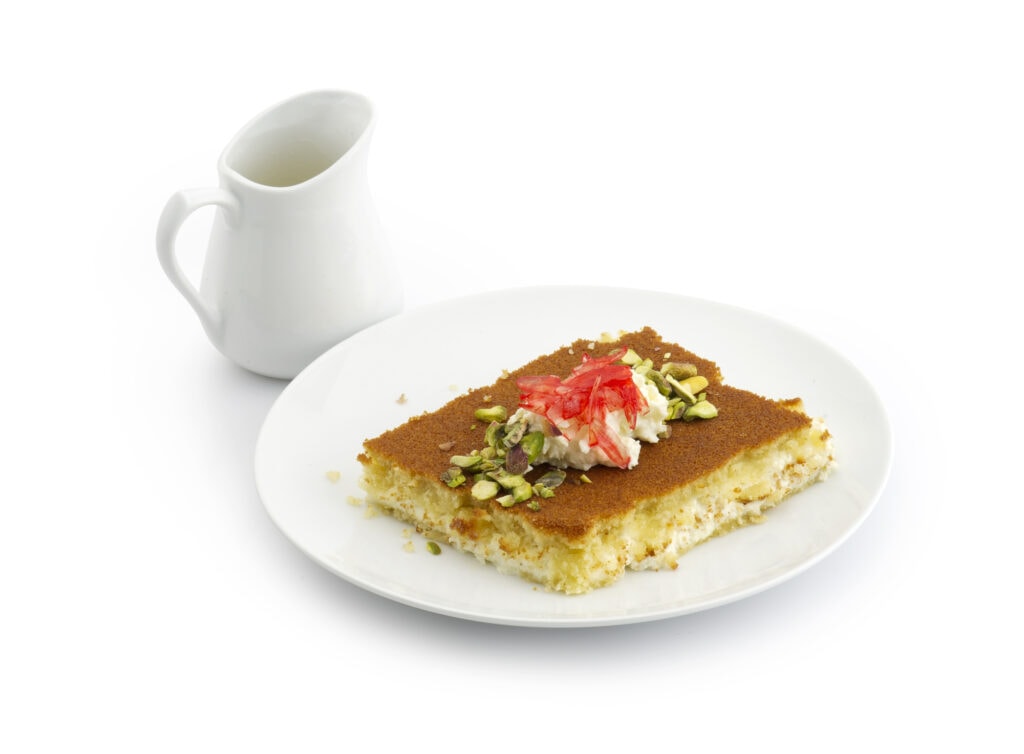
What is Turkish Delight?
Turkish Delight (it’s also called “locum”) is hands down one of the best Turkish food that goes back hundreds of years to the Ottoman Empire. This delightfully sweet and sticky treat is made in a huge variety of flavours. Flavours include traditional rose water, pistachio, and sweet orange flower water.
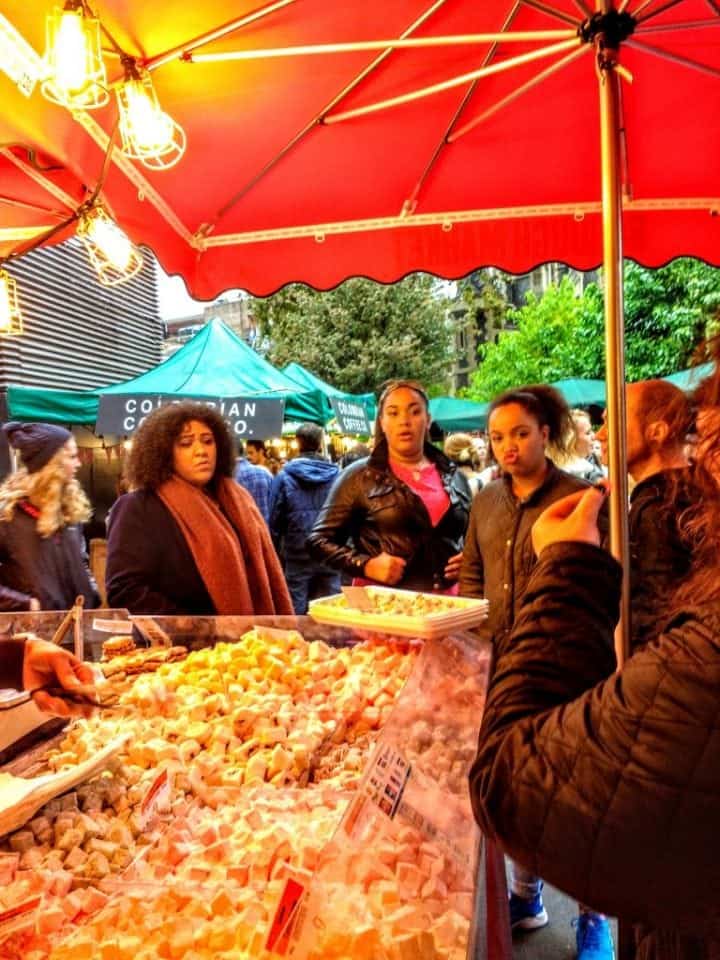
Turkish Delight is made by boiling sugar syrup and cornstarch together for several hours and then adding the flavouring. The “jelly” that results is then cut into squares and dusted with lots of powdered sugar.
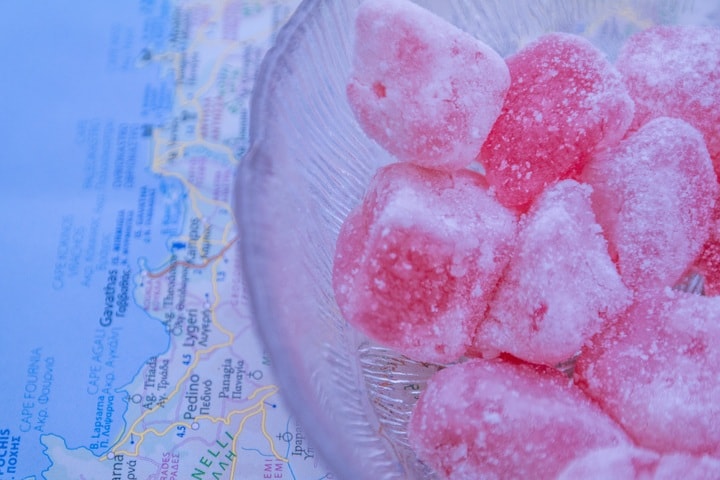
Mozzaik Pasta Cake
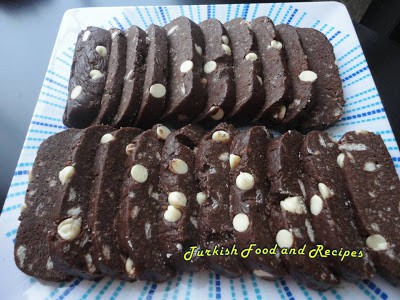
A sort of chocolate cake that is made with broken cookies (biscuits to you British). This is a no-bake cake that is very light and made with cookies that are similar to tea biscuits. The biscuits look like a mosaic when cut giving the cake its name.
The cake photo is from Turkish Food and Recipes and it’s a great place to find more information on Turkish food so don’t miss it. If you are looking for some fantastic traditional Turkish food recipes you will find them here.
I know I know it’s all very well to talk about this gorgeous food, but where do you go to eat some of it. Well, Anya of the RoadisCalling blog has written a fabulous article on 15 Incredibly Delicious Places Where to Eat in Istanbul. So if you are in the area check out some of her recommendations, you won’t be sorry.
Of course, it wouldn’t be a trip to Turkey unless you go shopping at the Bazaar and wander through some of the backstreets, internationally known as the first-ever shopping mall, showcasing an incredible array of goods in its 4,000 shops. Stop by the book bazaar, where the first printed book in Turkey was sold in 1729. Take yourself on a guided walking tour to see the highlights of Istanbul and the Grand Bazaar.
No visit to Istanbul is complete without stopping by the atmospheric Spice Bazaar. While the Grand Bazaar may be the largest and most famous of Istanbul’s covered bazaars, this spice market wins the prize for being the most colourful, fragrant, and often the most fun – as visitors can taste the goods on offer.
Built in 1664, as part of the Yeni Camii (New Mosque) complex, it is known in Turkish as Mısır Çarşısı, and sometimes translated to “Egyptian Bazaar”. Pick up some Turkish spices while you are there such as Turkish Red Chili (Pul Biber), Sumac or Bhaharat.
I hope you enjoy your trip to Turkey and get to try many new dishes and flavours while you are there. If you have been to Turkey what Turkish foods did you love?
If you taste something I’ve missed let me know.
“Afiyet Olsun,”
which literally means “may it be good for you!”
You might also like
Visiting the House of the Virgin Mary in Ephesus Turkey
The Sacred Temple of Artemis at Ephesus
